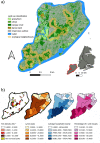Risk of tick-borne pathogen spillover into urban yards in New York City
- PMID: 35948911
- PMCID: PMC9365221
- DOI: 10.1186/s13071-022-05416-2
Risk of tick-borne pathogen spillover into urban yards in New York City
Abstract
Background: The incidence of tick-borne disease has increased dramatically in recent decades, with urban areas increasingly recognized as high-risk environments for exposure to infected ticks. Green spaces may play a key role in facilitating the invasion of ticks, hosts and pathogens into residential areas, particularly where they connect residential yards with larger natural areas (e.g. parks). However, the factors mediating tick distribution across heterogeneous urban landscapes remain poorly characterized.
Methods: Using generalized linear models in a multimodel inference framework, we determined the residential yard- and local landscape-level features associated with the presence of three tick species of current and growing public health importance in residential yards across Staten Island, a borough of New York City, in the state of New York, USA.
Results: The amount and configuration of canopy cover immediately surrounding residential yards was found to strongly predict the presence of Ixodes scapularis and Amblyomma americanum, but not that of Haemaphysalis longicornis. Within yards, we found a protective effect of fencing against I. scapularis and A. americanum, but not against H. longicornis. For all species, the presence of log and brush piles strongly increased the odds of finding ticks in yards.
Conclusions: The results highlight a considerable risk of tick exposure in residential yards in Staten Island and identify both yard- and landscape-level features associated with their distribution. In particular, the significance of log and brush piles for all three species supports recommendations for yard management as a means of reducing contact with ticks.
Keywords: Amblyomma; Haemaphysalis; Ixodes; Landscape metrics; Urban tick-borne disease.
© 2022. The Author(s).
Conflict of interest statement
The authors declare that the research was conducted in the absence of any commercial or financial relationships that could be construed as a potential conflict of interest.
Figures



References
-
- US Centers for Disease Control and Prevention (CDC). Tickborne disease surveillance data summary. 2019. https://www.cdc.gov/ticks/data-summary/index.html. Accessed 12 Feb 2022.
-
- US Centers for Disease Control and Prevention (CDC). Tick-borne diseases of the United States. 2016. http://www.cdc.gov/ticks.diseases/. Accessed 10 Jan 2021.
MeSH terms
Grants and funding
LinkOut - more resources
Full Text Sources
Medical

